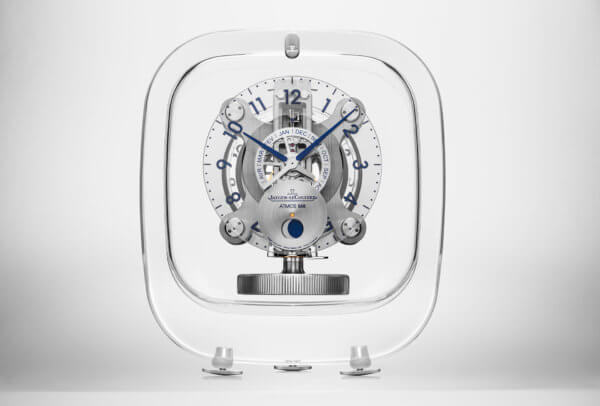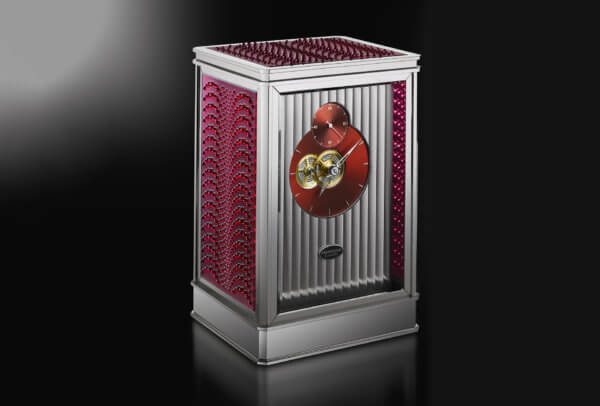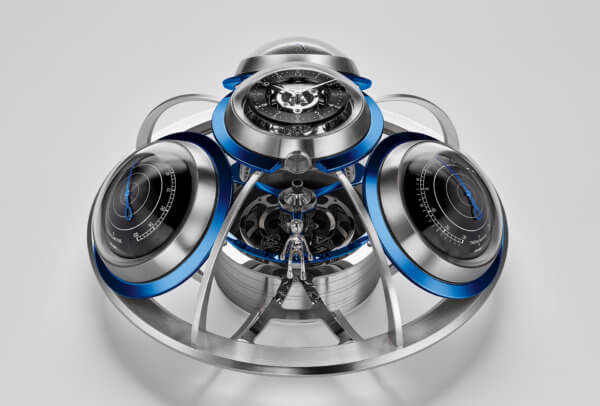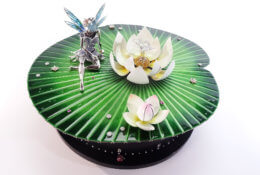In a world that thrives on electronics, table clocks can seem strangely out of place, a throwback to another era, when in reality we are drawn to them precisely because of their mechanical cogs and gears. Not just timepieces, they are kinetic sculptures, and for many brands the measuring of time by mechanical means becomes all the more eloquent in the company of the métiers d’art. Some brands make only occasional forays into clockmaking while for others, clocks are as much a part of their identity as watches. We take a closer look.
Jaeger-LeCoultre, a breath of fresh air
The clue is in the name: Jaeger-LeCoultre’s Atmos lives literally on fresh air. Invented in 1928 by a Swiss engineer, Jean-Léon Reutter, it was Jacques-David LeCoultre and his watchmakers who, from 1932, transformed the prototype into a reliable working clock. Four years later, Jaeger-LeCoultre bought the patents and production of the Atmos could begin.

An Atmos clock runs on the energy provided by a mixture of gases inside a sealed capsule, which expand and contract as temperature changes. Amazing! A rise or fall of 1°C will power the movement for 48 hours. No winding is required and, theoretically, the mechanism has an unlimited lifespan. The introduction of complications in 1990 made the Atmos even more magical – and all the more impressive from a mechanical point of view, considering how little power is actually available.
While traditionally housed inside an Art Deco-inspired glass case, these past few years have seen a number of original, and spectacular, interpretations in terms of both design and decoration. Examples include the limited-edition Atmos Marqueterie whose precious wood-inlay cabinets reproduce the paintings of Alfons Mucha or Gustav Klimt. In a contemporary vein, in 2008, 2010 and again in 2017, Jaeger-LeCoultre worked with the Australian designer Marc Newson to create Atmos clocks encased in perfectly smooth, flawlessly transparent, rounded cubes whose manufacture was entrusted to the specialist crystalworks of Baccarat.
Parmigiani's calling card
When Michel Parmigiani struck out on his own, the very first timepiece he made was a table clock. Now this isn’t as outlandish as it may sound, given that Parmigiani began his career as a restorer of antique clocks. Very probably he recognised the table clock as an excellent means of demonstrating the full extent of his expertise and making a smooth transition to his new activity. Presented in 1996, the Fleur d’Orient clock was certainly a remarkable calling card, for its mechanism, finishing, gem-setting and design. Today, Parmigiani Fleurier continues to explore this aspect of time measurement with the same talent and enthusiasm.
Certain of its clocks are clearly descended from much earlier mechanisms; think of the Hippologia, in which a mare and her foal canter across the surface, or The Dragon and The Pearl of Wisdom, another automata clock, this time inspired by the founding myth of Chinese civilisation. Others, in contrast, are undeniably modern, particularly since the advent of the 15-Day Table Clock. Equipped with a patented 15-day movement, it made its debut in 2012 inside a glass and solid silver case. The following year it returned in a stunning Lalique crystal case whose panels are embellished with the famous Coutard motif; a spray of delicate water droplets which René Lalique imagined for the Coutard Fountain in 1935, part of a luxury shopping gallery on the Champs-Elysées.

Inspired by the success of this maiden collaboration, Parmigiani Fleurier and Lalique went on to produce three sumptuous one-off timepieces, presented in 2015. The Toric Lépine is a diamond-set pocket watch which transforms into a table clock when suspended inside a crystal case, again with a Coutard decoration of nymphs surrounded by water droplets. The Soleil de Gaïa and Serpent clocks are inspired by Le Jour et La Nuit, a clock designed by Lalique in 1926. Male and female figures symbolising day and night, in colourless or amber crystal, frame a gold clock whose dial is accented with mother-of-pearl inlay.
MB&F and L'Epée 1839, the sky's the limit
The one brand that has done more than any to reinvent the art of clockmaking has to be MB&F. In fact clocks have proved a natural fit for its concept of three-dimensional mechanical sculptures that are equal parts fantasy and sophistication. In the space of four years (since 2014), the brand has released eight extraordinarily imaginative designs, with two to five versions of each, in limited editions of between 18 and 200 pieces. We’ve seen animal-inspired clocks with the Arachnophobia-spider and the Octopod-octopus; we’ve seen robot-clocks by the names of Melchior, Sherman and Balthazar, and spaceship-clocks in the form of Starfleet, Destination Moon and, the latest to date, The Fifth Element. Introduced this year, it is actually a horological weather station comprising four detachable and interchangeable elements – a clock, a barometer, a hygrograph and a thermometer – contained within the fifth element, the mothership. The form of this mothership, inspired by Fifties and Sixties sci-fi, had to be rethought several times, experimenting multiple configurations. As we’ve come to expect from MB&F, there’s also the humorous touch of Ross, the alien pilot who steers The Fifth Element safely through the galaxy, scanning the skies as he rotates around the cockpit. Like all MB&F clocks, The Fifth Element is a co-creation with L’Epée 1839.

L’Epée 1839 is Switzerland’s last remaining specialist manufacturer of high-end clocks. Originally French, the company was taken over by Swiss manufacturer Swiza in 2008. After some reshuffling in 2009, all the mechanical clocks were brought under the L’Epée 1839 name. Today’s collections range from the classical Carriage Clocks to the sleek lines of Contemporary Timepieces, to the fantasy creations in the Creative Art collection. Introduced in 2014, this new range brought with it a new direction. The first clock in the collection, the Starfleet, was also the first in the ongoing collaboration between L’Epée and MB&F. At the same time, the Creative Art range is home to the spectacular clocks which L’Epée designs in-house or with independent artists, and produces in limited editions (usually 50 per version with 100 or 200 pieces in all). Fifth in line and the latest to date, Time Machine is contained inside a glass cylinder, with a propeller at one end to wind the movement and a second propeller at the opposite end to set the time. The cylinder can be made to spin on the tripod that provides a stable base. The capsule is a shout-out to the time-travel machine from the classic 1960 sci-fi movie, The Time Machine, while the tripod suggests the temporal convector of a DeLorean car. Make no mistake, the Creative Art collection is L’Epée 1839’s passport to the future!
















